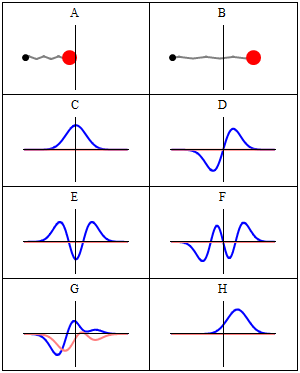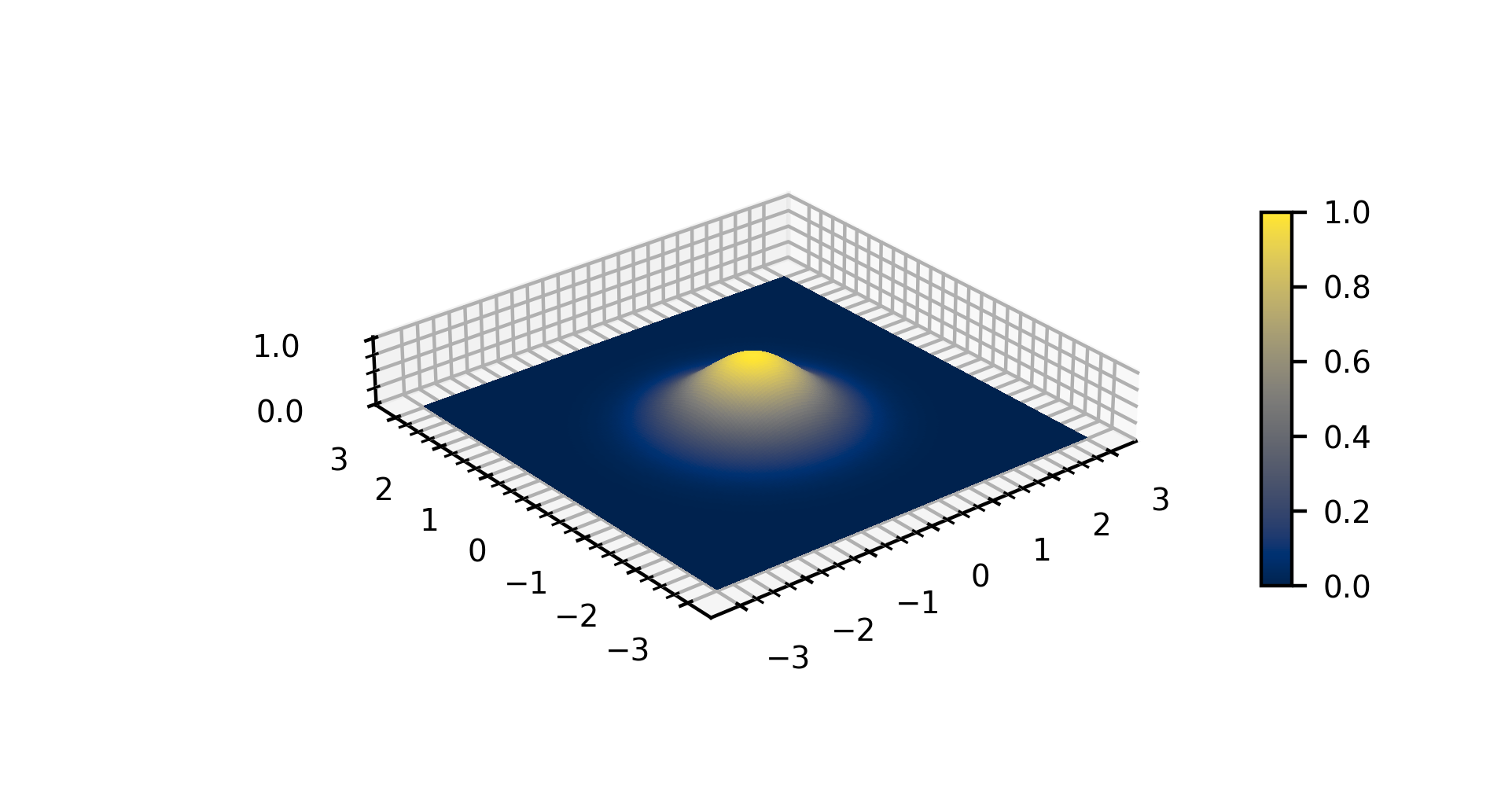|
Gausson (physics)
The Gausson is a soliton which is the solution of the logarithmic Schrödinger equation, which describes a quantum particle in a possible nonlinear quantum mechanics. The logarithmic Schrödinger equation preserves the dimensional homogeneity of the equation, i.e. the product of the independent solutions in one dimension remain the solution in multiple dimensions. While the nonlinearity alone cannot cause the quantum entanglement between dimensions, the logarithmic Schrödinger equation can be solved by the separation of variables. Let the nonlinear Logarithmic Schrödinger equation in one dimension will be given by (\hbar = 1, unit mass m=1): :i = -\frac \frac- a \ln , \psi, ^2\psi Let assume the Galilean invariance i.e. :\frac\psi(x,t)=e^\psi(x-k t) Substituting :\fracy=x-k t The first equation can be written as : -\frac \left \right2 \psi -a \ln , \psi, ^2 \psi=\left( E + \frac \right) \psi Substituting additionally :\frac\Psi(y)=e^\psi(y) and assuming :\Psi(y)=N ... [...More Info...] [...Related Items...] OR: [Wikipedia] [Google] [Baidu] |
Soliton
In mathematics and physics, a soliton is a nonlinear, self-reinforcing, localized wave packet that is , in that it preserves its shape while propagating freely, at constant velocity, and recovers it even after collisions with other such localized wave packets. Its remarkable stability can be traced to a balanced cancellation of nonlinear and dispersive effects in the medium.Dispersive effects are a property of certain systems where the speed of a wave depends on its frequency. Solitons were subsequently found to provide stable solutions of a wide class of weakly nonlinear dispersive partial differential equations describing physical systems. The soliton phenomenon was first described in 1834 by John Scott Russell who observed a solitary wave in the Union Canal in Scotland. He reproduced the phenomenon in a wave tank and named it the " Wave of Translation". The Korteweg–de Vries equation was later formulated to model such waves, and the term "soliton" was coined by Zabu ... [...More Info...] [...Related Items...] OR: [Wikipedia] [Google] [Baidu] |
Logarithmic Schrödinger Equation
In theoretical physics, the logarithmic Schrödinger equation (sometimes abbreviated as LNSE or LogSE) is one of the nonlinear modifications of Schrödinger's equation, first proposed by Gerald H. Rosen in its relativistic version (with D'Alembertian instead of Laplacian and first-order time derivative) in 1969. It is a classical wave equation with applications to extensions of quantum mechanics, quantum optics, nuclear physics, transport and diffusion phenomena, open quantum systems and information theory, effective quantum gravity and physical vacuum models and theory of superfluidity and Bose–Einstein condensation. It is an example of an integrable model. The equation The logarithmic Schrödinger equation is a partial differential equation. In mathematics and mathematical physics one often uses its dimensionless form: i \frac + \nabla^2 \psi + \psi \ln , \psi, ^2 = 0. for the complex-valued function of the particles position vector at time , and \nabla^2 \psi = \fr ... [...More Info...] [...Related Items...] OR: [Wikipedia] [Google] [Baidu] |
Nonlinear System
In mathematics and science, a nonlinear system (or a non-linear system) is a system in which the change of the output is not proportional to the change of the input. Nonlinear problems are of interest to engineers, biologists, physicists, mathematicians, and many other scientists since most systems are inherently nonlinear in nature. Nonlinear dynamical systems, describing changes in variables over time, may appear chaotic, unpredictable, or counterintuitive, contrasting with much simpler linear systems. Typically, the behavior of a nonlinear system is described in mathematics by a nonlinear system of equations, which is a set of simultaneous equations in which the unknowns (or the unknown functions in the case of differential equations) appear as variables of a polynomial of degree higher than one or in the argument of a function which is not a polynomial of degree one. In other words, in a nonlinear system of equations, the equation(s) to be solved cannot be written as a lin ... [...More Info...] [...Related Items...] OR: [Wikipedia] [Google] [Baidu] |
Quantum Mechanics
Quantum mechanics is the fundamental physical Scientific theory, theory that describes the behavior of matter and of light; its unusual characteristics typically occur at and below the scale of atoms. Reprinted, Addison-Wesley, 1989, It is the foundation of all quantum physics, which includes quantum chemistry, quantum field theory, quantum technology, and quantum information science. Quantum mechanics can describe many systems that classical physics cannot. Classical physics can describe many aspects of nature at an ordinary (macroscopic and Microscopic scale, (optical) microscopic) scale, but is not sufficient for describing them at very small submicroscopic (atomic and subatomic) scales. Classical mechanics can be derived from quantum mechanics as an approximation that is valid at ordinary scales. Quantum systems have Bound state, bound states that are Quantization (physics), quantized to Discrete mathematics, discrete values of energy, momentum, angular momentum, and ot ... [...More Info...] [...Related Items...] OR: [Wikipedia] [Google] [Baidu] |
Homogeneous Function
In mathematics, a homogeneous function is a function of several variables such that the following holds: If each of the function's arguments is multiplied by the same scalar (mathematics), scalar, then the function's value is multiplied by some power of this scalar; the power is called the degree of homogeneity, or simply the ''degree''. That is, if is an integer, a function of variables is homogeneous of degree if :f(sx_1,\ldots, sx_n)=s^k f(x_1,\ldots, x_n) for every x_1, \ldots, x_n, and s\ne 0. This is also referred to a ''th-degree'' or ''th-order'' homogeneous function. For example, a homogeneous polynomial of degree defines a homogeneous function of degree . The above definition extends to functions whose domain of a function, domain and codomain are vector spaces over a Field (mathematics), field : a function f : V \to W between two -vector spaces is ''homogeneous'' of degree k if for all nonzero s \in F and v \in V. This definition is often further generalized to f ... [...More Info...] [...Related Items...] OR: [Wikipedia] [Google] [Baidu] |
Quantum Entanglement
Quantum entanglement is the phenomenon where the quantum state of each Subatomic particle, particle in a group cannot be described independently of the state of the others, even when the particles are separated by a large distance. The topic of quantum entanglement is at the heart of the disparity between classical physics and quantum physics: entanglement is a primary feature of quantum mechanics not present in classical mechanics. Measurement#Quantum mechanics, Measurements of physical properties such as position (vector), position, momentum, Spin (physics), spin, and polarization (waves), polarization performed on entangled particles can, in some cases, be found to be perfectly correlated. For example, if a pair of entangled particles is generated such that their total spin is known to be zero, and one particle is found to have clockwise spin on a first axis, then the spin of the other particle, measured on the same axis, is found to be anticlockwise. However, this behavior ... [...More Info...] [...Related Items...] OR: [Wikipedia] [Google] [Baidu] |
Separation Of Variables
In mathematics, separation of variables (also known as the Fourier method) is any of several methods for solving ordinary differential equation, ordinary and partial differential equations, in which algebra allows one to rewrite an equation so that each of two variables occurs on a different side of the equation. Ordinary differential equations (ODE) A differential equation for the unknown f(x) is separable if it can be written in the form :\frac f(x) = g(x)h(f(x)) where g and h are given functions. This is perhaps more transparent when written using y = f(x) as: :\frac=g(x)h(y). So now as long as ''h''(''y'') ≠ 0, we can rearrange terms to obtain: : = g(x) \, dx, where the two variables ''x'' and ''y'' have been separated. Note ''dx'' (and ''dy'') can be viewed, at a simple level, as just a convenient notation, which provides a handy mnemonic aid for assisting with manipulations. A formal definition of ''dx'' as a differential (infinitesimal) is somewhat advanced. Al ... [...More Info...] [...Related Items...] OR: [Wikipedia] [Google] [Baidu] |
Logarithmic Schrödinger Equation
In theoretical physics, the logarithmic Schrödinger equation (sometimes abbreviated as LNSE or LogSE) is one of the nonlinear modifications of Schrödinger's equation, first proposed by Gerald H. Rosen in its relativistic version (with D'Alembertian instead of Laplacian and first-order time derivative) in 1969. It is a classical wave equation with applications to extensions of quantum mechanics, quantum optics, nuclear physics, transport and diffusion phenomena, open quantum systems and information theory, effective quantum gravity and physical vacuum models and theory of superfluidity and Bose–Einstein condensation. It is an example of an integrable model. The equation The logarithmic Schrödinger equation is a partial differential equation. In mathematics and mathematical physics one often uses its dimensionless form: i \frac + \nabla^2 \psi + \psi \ln , \psi, ^2 = 0. for the complex-valued function of the particles position vector at time , and \nabla^2 \psi = \fr ... [...More Info...] [...Related Items...] OR: [Wikipedia] [Google] [Baidu] |
Galilean Invariance
Galilean invariance or Galilean relativity states that the laws of motion are the same in all inertial frames of reference. Galileo Galilei first described this principle in 1632 in his ''Dialogue Concerning the Two Chief World Systems'' using the example of a ship travelling at constant velocity, without rocking, on a smooth sea; any observer below the deck would not be able to tell whether the ship was moving or stationary. Formulation Specifically, the term ''Galilean invariance'' today usually refers to this principle as applied to Newtonian mechanics, that is, Newton's laws of motion hold in all frames related to one another by a Galilean transformation. In other words, all frames related to one another by such a transformation are inertial (meaning, Newton's equation of motion is valid in these frames). In this context it is sometimes called ''Newtonian relativity''. Among the axioms from Newton's theory are: #There exists an '' absolute space'', in which Newton's laws are ... [...More Info...] [...Related Items...] OR: [Wikipedia] [Google] [Baidu] |
Quantum Harmonic Oscillator
The quantum harmonic oscillator is the quantum-mechanical analog of the classical harmonic oscillator. Because an arbitrary smooth potential can usually be approximated as a harmonic potential at the vicinity of a stable equilibrium point, it is one of the most important model systems in quantum mechanics. Furthermore, it is one of the few quantum-mechanical systems for which an exact, analytical solution is known. One-dimensional harmonic oscillator Hamiltonian and energy eigenstates The Hamiltonian of the particle is: \hat H = \frac + \frac k ^2 = \frac + \frac m \omega^2 ^2 \, , where is the particle's mass, is the force constant, \omega = \sqrt is the angular frequency of the oscillator, \hat is the position operator (given by in the coordinate basis), and \hat is the momentum operator (given by \hat p = -i \hbar \, \partial / \partial x in the coordinate basis). The first term in the Hamiltonian represents the kinetic energy of the particle, and the second ... [...More Info...] [...Related Items...] OR: [Wikipedia] [Google] [Baidu] |
Gaussian Function
In mathematics, a Gaussian function, often simply referred to as a Gaussian, is a function (mathematics), function of the base form f(x) = \exp (-x^2) and with parametric extension f(x) = a \exp\left( -\frac \right) for arbitrary real number, real constants , and non-zero . It is named after the mathematician Carl Friedrich Gauss. The graph of a function, graph of a Gaussian is a characteristic symmetric "Normal distribution, bell curve" shape. The parameter is the height of the curve's peak, is the position of the center of the peak, and (the standard deviation, sometimes called the Gaussian Root mean square, RMS width) controls the width of the "bell". Gaussian functions are often used to represent the probability density function of a normal distribution, normally distributed random variable with expected value and variance . In this case, the Gaussian is of the form g(x) = \frac \exp\left( -\frac \frac \right). Gaussian functions are widely used in statistics to describ ... [...More Info...] [...Related Items...] OR: [Wikipedia] [Google] [Baidu] |
Quantum Mechanics
Quantum mechanics is the fundamental physical Scientific theory, theory that describes the behavior of matter and of light; its unusual characteristics typically occur at and below the scale of atoms. Reprinted, Addison-Wesley, 1989, It is the foundation of all quantum physics, which includes quantum chemistry, quantum field theory, quantum technology, and quantum information science. Quantum mechanics can describe many systems that classical physics cannot. Classical physics can describe many aspects of nature at an ordinary (macroscopic and Microscopic scale, (optical) microscopic) scale, but is not sufficient for describing them at very small submicroscopic (atomic and subatomic) scales. Classical mechanics can be derived from quantum mechanics as an approximation that is valid at ordinary scales. Quantum systems have Bound state, bound states that are Quantization (physics), quantized to Discrete mathematics, discrete values of energy, momentum, angular momentum, and ot ... [...More Info...] [...Related Items...] OR: [Wikipedia] [Google] [Baidu] |





